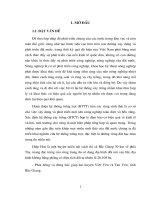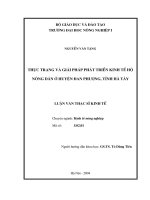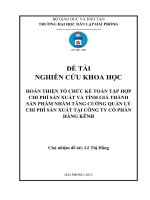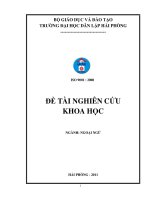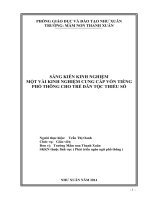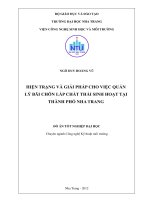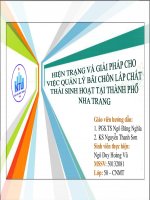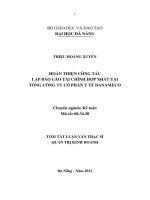Các hoạt động khuyến khích học ngữ pháp cho sinh viên học Toeic cấp độ một tại trường Đại học Dân Lập Hải Phòng
Bạn đang xem bản rút gọn của tài liệu. Xem và tải ngay bản đầy đủ của tài liệu tại đây (1.25 MB, 70 trang )
BỘ GIÁO DỤC VÀ ĐÀO TẠO
TRƯỜNG ĐẠI HỌC DÂN LẬP HẢI PHÒNG
-------------------------------
ISO 9001 : 2008
ĐỀ TÀI NGHIÊN CỨU
KHOA HỌC
NGÀNH: NGOẠI NGỮ
HẢI PHÒNG - 2011
1
HAIPHONG PRIVATE UNIVESITY
FOREIGN LANGUAGES DEPARTMENT
-----------------------------------
ISO 9001:2008
SCIENTIFIC RESEARCH
HOW TO MOTIVATE STUDENTS OF THE FIRST
LEVEL TO LEARN ENGLISH GRAMMAR IN THE
TOEIC COURSE AT Haiphong private
university
)
By: Pham Thi Thu Hang, M.A
Nguyen Thi Hoa, M.A
HAI PHONG - 2011
2
TABLE OF CONTENTS
Table of contents ........................................................................................... i
Acknowledgements ........................................................................................ iii
List of Abbreviations..................................................................................... iv
List of tables, charts,and figures .................................................................. v
Abstract .......................................................................................................... vi
PART I INTRODUCTION ........................................................................ 1
1. Rationale.................................................................................................... 1
2. Aims of the study ...................................................................................... 1
3. Scope of the study ..................................................................................... 2
4. Research question...................................................................................... 2
5. Methods of the study ................................................................................. 2
6. Design of the study.................................................................................... 3
PART II DEVELOPMENT ....................................................................... 4
Chapter 1 Literature Review ....................................................................... 4
I. 1. Grammar ................................................................................................ 4
I.1.1 What is teaching grammar? ................................................................ 4
I.1.1.1. The role of grammar in English Language Teaching……… ............. 4
I.1.1.2. Deductive versus Inductive Approach ................................................ 6
I.1.2. TOEIC test and TOEIC grammar ..................................................... 6
I. 2. Motivation ............................................................................................. 9
I.2.1 What is motivation? ................................................................................ 9
I.2.2 Classification of motivation ................................................................... 10
I.2.2.1. Intrinsic motivation ............................................................................. 11
I.2.2.2. Extrinsic motivation ............................................................................ 11
3
I.3. Grammar and motivation ...................................................................... 11
I.3.1. Grammar and Communicative Approach .............................................. 11
I.3.2. The role of motivation in teaching grammar ......................................... 12
I.3.3. Summary of the chapter ......................................................................... 13
Chapter 2. The Study .................................................................................... 14
II.1. Haiphong Private University and current situation of teaching and learning
TOEIC at the Haiphong Private University…………………………..14
II.1.1. Haiphong Private University and English teachers ....................................... 14
II.1.2 The TOEIC programme at HPU ..................................................................... 14
II.1.3. The content of the TOEIC Level 1 ................................................................ 15
II.2.Questionnaire ......................................................................................... 15
II.2.1.A description of population ................................................................... 15
II.2.2. The means of research .......................................................................... 16
II.3. The analysis of the questionaire results .............................................. 16
II.3.1. Interpretation on results of students‟ questionnaires ............................ 16
II.3.2. Interpretation on results of teachers‟ questionnaires ............................ 26
II.4. The analysis of the tests’ results .......................................................... 33
II.5. Finding of the research ......................................................................... 34
Chapter III. Pedagogical suggestions to motivate the students of level 1 in
Toeic course at Haiphong Private University to learn grammar ............. 35
III.1. Show the students the connection between grammar and the TOEIC
Test.................................................................................................................. 35
III.2. Show the students the connection between grammar and their lives.
III.2.1. Introduce hot elements ........................................................................ 35
III.2.2. Get the students involved in the class activities ................................. 37
III.2.3. Create opportunities for self-expression ............................................. 37
III.3. Use motivating classroom activities ................................................... 37
4
III.3.1. Personalized warm up activities .......................................................... 37
III.3.2.Vivid teaching: Using pictures, charts, and videos .............................. 38
III.3.3.Tangible teaching: games, index cards, quiz, crosswords ................... 42
III.3.4.Vary learning activities: interpersonal , kinesthetic, and musical ....... 46
III.3.5. Each learner is involved: assign pair and group activities .................. 50
III.3.6.Combine deductive and inductive teaching ......................................... 52
III. 3.7. Context-based teaching ..................................................................... 52
III. 3.8. Creating Fun ....................................................................................... 53
III. 3.9. Inspire students‟ curiosity .................................................................. 54
III. 3.10. Provide a variety of choices ............................................................. 55
III.4. Provide enough input and guide out-of-class work .......................... 55
III.4.1.Introduce learning websites ................................................................. 55
III.4.2. Provide supplementary materials ........................................................ 56
III.4.3. Home preparation and presentation .................................................... 58
III.4.4. Quality homework ............................................................................... 59
III.4.5. Evaluate the out-of class works and provide weekly feedback ......... 59
Part 3. Conclusion ......................................................................................... 60
REFERENCES
APPENDIX 1
APPENDIX 2
Appendix 3
5
ACKNOWLEDGEMENTS
Firstly, we wish to express our sincere gratitude to our consultant, Doctor
Nguyen Xuan Thom, for his invaluable inspiration and suggestion during the
time he taught at Haiphong Private University.
We are grateful to all lecturers of the Foreign Languages Department,
Haiphong Private University
for their interesting lectures, especially their
contribution to the completion of this research.
We also thank our lovely students at Haiphong Private University for
their cooperation in completing the survey questionnaires as well as their
willingness to share their ideas on this research.
Last but not least, we also own a gratitude to our husbands and children
for their untiring supports.
Haiphong, November 2011
The authors
6
Part 1. Introduction
1. Rationale
It can not be denied that English has always been a priority language and it is
compulsory subjects in all levels of education system all over the world. Nonetheless,
in
many
universities,
the
teaching
of
English
has
not
developed
the
students‟competence, creativeness, as well as their interest yet. This fact is more
obvious in the case of teaching grammar. Still in many classrooms we often see bored
students trying to do long and difficult grammar exercises again and again. Can such
tiring lessons have any effects? This question always exists in our minds-the teachers
of English in Haiphong Private University. How can we make our students like
learning English? How can we motivate them to learn grammar effectively without
boredom and tiredness? This question is the main reason for us to carry out this
research.
2. Aims of the research
The major aims of the research are:
-
to motivate level- one students
in particular and students of
Toeic in
general in learning grammar.
-
to help students build up the basic knowledge of English grammar system.
-
to facilitate students in self-study process.
-
to aid teachers at FLD as a source of supplementary in teaching grammar of
Toeic course.
7
3. Scope of the research
The subjects of this research are the students of the first level in the Toeic
course at Haiphong Private University .The researchers do not cover the teaching
grammar of all levels but only focus on level one because they are the beginners of the
Toeic course who need to build up a basic foundation of English grammar system as
well as being familiar with the approach
of
teaching grammar in the light of
Communicative Method.
4. Research question
As a matter of fact, many students in the first level of Toeic course in Haiphong
Private University still show their lack of homework completion, poor attendance and
incorrect results of grammar exercises. Originating from these facts, we create some
hypotheses ; for instance, either the lessons are tedious and repetitive or the grammar
knowledge might be difficult to them. These hypotheses are the foundation for us to set
up research questions during the completion of the study.
The study will attempt to find the answers to the following research questions:
- What is the role of grammar in the Toeic course of Haiphong Private
University ?
- Is motivation necessary and important in all grammar lessons?
- What benefits can teachers and students get from different motivating
activities in grammar lessons ?
5. Methods of the study
In order to find the answer for the assumption that the researchers have made,
the method applied in this research is mainly quantitative in which interviews and
questionnaires are compiled and delivered among the teachers in Foreign Language
Department of Haiphong Private University and the students of the first level in the
Toeic course. Besides, real classroom observations are carried to support the
8
authenticity of the study. After the adequate data have been collected and analysed ,
the authors give comments and conclusion of the study .
6. Design of the study
The study consists of three parts:
Part I – Introduction – provides the rationale for the study and sets up the
aims, scope, research questions and methods of the study.
Part II – Development – consists of three chapters:
- Chapter 1 is concerned with the literature review of the study.
- Chapter 2 investigates the current situation of teaching and learning English
grammar at Haiphong Private University through class observation, interviews and
questionnaires, then carries out data analysis, comparison, findings and discussion.
-Chapter 3 provides suggestions, or measures to overcome difficulties when
teaching grammar in class by using different motivating activites in class , as well as
examples of activities to teach ten grammar points in the teaching syllabus of grammar
for the first level students in Toeic course.
Part III – Conclusion – summarizes and makes a conclusion to the main points
which have been explored in the study, propose recommendations to develop the
effectiveness of teaching and learning English, some suggestions for future research
and the limitation of the study.
9
PART II
Chapter 1
DEVELOPMENT
Literature Review
I.1.1 What is teaching grammar?
I.1.1.1. The role of grammar in teaching and learning English
In the development of foreign language teaching, grammar has always been an
important component and indispensable language input.
On one hand, teaching grammar helps students use the language accurately. Hedge
(2000:25) claims that many teachers give grammar teaching their great attention in
their classroom methodology. Grammar gains such importance because of its inevitable
role. Apart from vocabulary, students need to know grammar to understand how a
sentence is written or how words are combined together to understand the proper
meaning. Without grammar or with a poor knowledge of grammar, they may get
confused with complicated expressions. On the other hand, when students have a
sound basis of grammar knowledge, they feel easy to improve our four language skills.
Pacheler (1999) state: "the rules of grammar facilitate communicative economy" (p.
94). That is to say that thanks to grammar we can produce unlimited number of
utterances and sentences with a limited a number of words and sounds. Widodo
(2006:32) also stress that the roles of grammar go beyond the sentence and utterance
level to affect the four skills: listening, speaking, reading and writing. In listening and
reading, we cannot grasp the intended information or make the interrelationship
between the parts of the discourse if they have not had a basis of grammatical
knowledge. In speaking and writing, producing comprehensible meaningful sentences
and utterances, and relating them depend to a large extent on grammar.
Therefore, teaching grammar not only provides the learners with necessary items
of language as well as the standard rules but also gives them opportunities for better
communicative practices in the use of languages.
10
I.1.1.2 . Deductive versus Inductive Approach
Thornbury (1999:12) defines deductive approach as the way of teaching grammar
where rules are presented first and then their applications through examples, and
inductive approach as the way of teaching grammar through examples from which
rules are understood. These two approaches are firmly rooted in linguistic and
psychological theories.
According to Broughton et al. (1980:79), the deductive approach is supported
linguistically by structuralisms and psychologically by the behaviourist; while, the
inductive approach is supported linguistically by the generative grammarians and
psychologically by the mentalists. The behaviourists for examples emphasize the
importance of reinforcement through repetition of correct form that characterizes the
deductive approach and the mentalists' emphasize the subconscious cognitive devices
that are used in the inductive approach which are similar to those used in the first
language acquisition (ibid).
Widodo (2006:8) suggests five advantages for each approach. Deductive approach
could be time–saving since it points in a direct way to the rule; simultaneously,
inductive approach trains learners to be autonomous through the indirect way of
knowing the rule. It is the cognitive ability of adults which is developed in the
inductive approach; at the same time, in the deductive approach, it is their cognitive
process and its role to use metalanguage which is acknowledged. When teaching
deductively, a number of applications and practice is immediately given, whereas,
teaching inductively helps the learners to be more active in the learning process. On the
one hand, learners with analytical style find themselves at ease when learning
deductively; on the other hand, there are learners who are interested in the challenge
presented in problem-solving ability found in the inductive way of teaching. There are
some rules or aspects of rules, like form, which can be simply and clearly presented
deductively not to confuse the learners; if the problem solving is done collaboratively,
learners will have more opportunities to use the language.
11
I.1.2 TOEIC test and TOEIC grammar
The TOEIC originated from the Japanese Ministry of International Trade and
Industry.This group requested the Educational Testing Service in Princeton, New
Jersey in the middle 1970's to design an exam to measure the English-language
listening comprehension
and reading comprehension
skills of individuals whose
native language is not English. Most examinees are in their mid-twenties to late forties
who are working for a corporation. However, TOEIC test-takers have recently included
many university graduating people, because corporations are requiring TOEIC scores
for new employees more and more often. The TOEIC is used primarily by corporate
clients, worldwide." (Wilson, 1989). From its beginning nearly 20 years ago, the use
of TOEIC has spread from Japan throughout Asia, and it is becoming more frequently
used throughout Europe and South America.
Listening comprehension section consists of four parts: Photograph description,
Question and Response, Short Conversation, and Short Talk. This section lasts There
are 100 questions on tape in the TOEIC; testing time is about 50 minutes. Timing of
questions is roughly 30 seconds per question. There is a "thinking gap" of about 10
seconds per question on the tape.
In the reading comprehension subtest, two subsections which are Part V and Part VI
evaluate the testee's ability to use English grammar in a relatively formal manner.The
grammatical questions are included in three task types: Incomplete Sentences and Error
Recognition, or Incomplete Texts .These tasks assess the examinee's knowledge of
English structure, or grammar. These TOEIC subtests are supposed to "measure ability
to recognize language that is appropriate for standard written English," (ETS, 1993).
There are 100 questions in the Reading Comprehension section; 60 questions in
the Grammar subtest and 40 questions in the Reading subtest, with a total time of 75
minutes. The Grammar and Reading Comprehension sections are timed together.
Examinees should allow about 25 minutes (or less) for the Grammar questions. If an
12
examinee can quickly (and accurately) go through the Grammar section, then more
time is left for the Reading Comprehension questions.
We can see the samples of Grammar part in the Reading test as follows:
Question Example: Reading Comprehension
V. Incomplete Sentences: (Gilfert & Kim, 1995)
Read and choose the best answer
_____ girl over there is my sister.
(A) This
(B) Those
(C) These
(D) That
(D) is the answer that is grammatically correct.
Question Example: Reading Comprehension
Error Recognition: (Gilfert & Kim, 1996)
Read and circle the correct answer
In today's class middle, both parents have to work in order
(A)
all
(B)
to pay
(C)
their bills.
(D)
(A) is an error in word order, making it the correct answer.
Incomplete Texts: ( Anne Taylor& Garrett Byrne, 2007)
Read and circle the correct answer
13
Notice
From next week, all cars……………..are parked in front of the building will be towed
away. Any employees who want to park near the building must…
A. who
B. whose
C. that
D. what
B- is the correct answer
Besides, the Toeic testees should also bear in minds the range of grammar knowledge
that frequently appear in the test . Following are the common grammatical items found
in TOEIC:
1. Verbs
2. Adverb
3. Adjective
4. Noun and Pronoun
5. Conjunction
6. Preposition
7. Phrase/ clause
8. Comparative and Superlative
9. Gerund and Infinitive
10. Participle
11. Tense
12. Passive Voice
From above overview of Toeic test in general and Toeic grammar in particular,
we can realize that Grammar is one of three components in a Toeic test. Without an
adequate amount of grammar knowledge, a Toeic test-taker can not finish 60 questions
14
in the grammar part out of total 200 questions.This ratio of 60 to 200 is worth for us to
consider whether grammar is important or not in the Toeic test. Apart from that, with
poor knowledge of grammar, Toeic test-takers can not complete the listening task
quickly and correctly because so many listening formats are based on grammar. Let‟s
look at this example from “Oxford practice tests for the TOEIC test” published in 2000
for the tip of doing part II- Question and Response:
As in Part I, words may sound similar or be used out of context. Words from the
questions may be repeated in the response, but be used inaccurately. In addititon, there
is a potential trap with grammar. You will hear different types of questions: whquestions (who, what, when, where, why, and how), yes/no questions and tag questions.
When you hear a yes/no or a tag question, you may assume that the response will begin
with Yes or No. In the TOEIC test, as in real life, the response may answer the
question indirectly instead. For example:
Is there any cake left?
(A) I ate the last piece.
(B) Yes, the lake is on the left.
(C) No, I left early.
(A) is the correct option. The respondent doesn‟t answer with yes/no as would be
expected. However, we know the answer is no, because the respondent ate the last
piece”.
I.2. Motivation
I.2.1 What is motivation?
“Motivation is considered one of the most powerful driving forces on learning”
(Slavin, 2006, p.317).
Another theory on motivation can be seen from Littlewood‟s perspective
(1998:53) that “in second language learning as in every other field of human learning,
motivation is the crucial force which determines whether a learner embarks on a task
15
at all, how much energy he devotes to it, and how long he perseveres. It is a complex
phenomenon and includes many components: the individual’s drive, need for
achievement and success, curiosity, desire for stimulation and new experience, and so
on”.
Besides, according to Lightbown and Spada‟s (1999: 56) definition of motivation in
second language learning that “motivation in second language learning is a complex
phenomenon which can be defined in terms of two factors: learner’s communicative
needs and their attitudes towards the second community”.
Johnson and Johnson (2003), state that “motivation occurs within a net work of
interpersonal relationships” (p. 140).
Although many researchers agree on the undeniable effects of motivation, they
have not yet agreed on a unique theory to explain or define motivation. However, in
spite of the different aspects each theory focuses on in explaining motivation, they do
not contradict each other but rather complement one another to have an ultimate,
complete and clear view of what motivation is and how it is maintained.
I.2.2 Classification of motivation
Figure 1. Motivation to learn. Huitt, W. (2011).
16
I.2.2.1. Intrinsic motivation
Intrinsic motivation refers to motivation that is driven by an interest or enjoyment in
the task itself, and exists within the individual rather than relying on any external
pressure. Intrinsic motivation has been studied by social and educational psychologists
since the early 1970s. Research has found that it is usually associated with high
educational achievement and enjoyment by students. Students are likely to be
intrinsically motivated if they:
attribute their educational results to internal factors that they can control (e.g.
the amount of effort they put in),
believe they can be effective agents in reaching desired goals (i.e. the results are
not determined by luck),
are interested in mastering a topic, rather than just rote-learning to achieve
goodgrades.
/>
I.2.2.2. Extrinsic motivation
Extrinsic motivation comes from outside of the individual. Common extrinsic
motivations are rewards like money and grades, coercion and threat of punishment.
Competition is in general extrinsic because it encourages the performer to win and beat
others, not to enjoy the intrinsic rewards of the activity. A crowd cheering on the
individual and trophies are also extrinsic incentives.
/>I.3. Grammar and motivation
I.3.1. Grammar and Communicative Approach
Haynes (2007) states "to acquire a new language, learners need a source of natural
communication, memorizing grammar rules will not help them to speak and write
English quickly" (p. 11). This means that, it is more effective to learn grammar
17
communicatively so that L2/FL learner can produce it spontaneously rather than
teaching units of grammar as separate entities. According to Pacheler (1999),
communicative approach provides the learners, especially in large classes, with
situations where they can apply their language and their understanding of grammatical
rules and where they are able to make and correct their errors. This interactive way of
learning results in the meaningful use of language. Nunan (1996) states that for
communicative teaching grammar to be helpful, it should involve "achieving harmony
between functional interpretation and formal appropriacy" (p. 69). In other words,
teachers should relate in their classroom methodology usage and use and implement
them together. Al Moutawa and Kailani (1989) are also of the same opinion when they
suggest using the grammatical rules for communicative purposes in order for the
learner to learn the rules that construct a language and to have the ability to apply them
in communicative acts for real and natural communicative situations.
Thornbury (1999) says that communicative grammar teaching is sometimes referred to
as "covert grammar teaching" (p. 23). Covert grammar teaching involves teaching
grammar through doing communicative activities in communicative approach;
grammar would be therefore, according to Thornbury (1999), a means of tiding
meanings up as a way to achieve communicative competence.
I.3.2. The role of motivation in teaching grammar
So far, we have mentioned the definition of motivation and teaching grammar. It
is clear that motivation and grammar has a close relation ? How important is
motivation in teaching grammar? No one can deny that motivation can bring many
benefits to a grammar teacher in a lesson. Motivation helps learner realize the fun as
well as the neccesity of the knowledge. The learner can absorb the knowledge without
the enforcement and discouragement. They will attend different language activities
more naturally and enthusiactically. It is obvious that teachers
need to create
motivation in teaching grammar to make their students like the lessons so that their
study of grammar would be more effective.
18
I.3.3. Summary of the chapter
To summarize this chapter, it can be said that grammar plays a very important
part in teaching and learning English. However, grammar should be taught stimulately
and creatively by using motivating activities. The application of motivation is very
necessary to develop students‟ interest and understanding of the lesson. Those are the
main points in the literature review that the chapter is concerned with to carry out the
next steps of the study in Chapter 2.
19
Chapter 2 . The study
II.1. Haiphong Private University and current situation of teaching and learning
TOEIC at the university
II.1. Haiphong Private University and English teachers
Although Haiphong Private University has been founded for less than fifteen years, it
has been one of the best universities in the Private Sector . It has 14 departments from
which more than 12000 students have graduated and worked as engineers and officers
in many cities of Vietnam. It has always made effort to improve the training quality
by building a modern learning facility as well as collecting the best teaching staff.
Currently,there are more than 300 teachers who specialize in all fields including natural
science and social science subjects. The teachers of English account for the majority in
the foreign language department since they have to take in charge of English teaching
for all departments in the university. Most of them have obtained Master‟s degrees and
are continuing to improve not only their knowledge but also their teaching methods.
II.1.1 The TOEIC programme at HPU
Since 2008, the university has been applying TOEIC teaching into the
syllabuses to catch up with the new trend of training program in the country and the
world. TOEIC is the compulsory subject for all the non-major students in Haiphong
Private University. Therefore, TOEIC teaching is the main focus of English teaching in
the school. The department members have worked together to design an overall
syllabus for TOEIC program ranging from level 1 to level 5. The students in the
Natural Science Sector has to learn 19 credits to get 500 scores and pass TOEIC as the
20
prerequisites of graduation while the students in Social Science Sector do the same
with 22 credits equal to 600 scores in the course .
II.1.2 The content of the TOEIC Level 1
Level 1 of TOEIC in Haiphong Private University is designed to provide students with
the basic knowledge of English. The total time allotment of level 1 is 90 periods
covering Reward textbook(Macmilan Heinemann: 1994) , Learning to listen (Lin
Lougheed), and Grammar and Reading books compiled by the teachers of the English
departments. The grammar subject lasts in 30 periods and includes the following
grammatical points:
Unit 1: Grammar: Simple present Tense -supplementary activities
Unit 2: Grammar: Futute expressions- supplementary activities
Unit 3: Grammar: Articles-supplementary activities
Unit 4: Grammar: Gerunds and infinitives (Part1)-supplementary activities
Unit 5: Grammar: Present continuous-supplementary activities
Unit 6: Grammar: Simple past- supplementary activities
Unit 7: Grammar: Countable and Uncountable Nouns
Unit 8: Grammar: Conjunctions- supplementary activities
Unit9: Grammar: Possessive Adjectives and Possessive Cases- supplementary
activities
II.2 Questionnaire
II.2.1. A description of the population
The whole population of the study consists of the first year students of English as Nonmajor ones atHaiphong Private University during the academic year 2011-2012 plus
with the first year English grammar teachers at the same university. The total number
21
of the students' population is one hundred and fifty students
and the teachers'
population is 15 teachers. The students are from different geographical regions in the
North of Vietnam and two genders; male and female. The teachers have different
degrees and different years of working experience at the Department of English at
Haiphong Private University.
This population has been chosen for two reasons. The first reason is that 1st year
students are freshman;thus, they would have expected to get a syllabus of Grammar
course introducing the initial, basic, and adequate fund of grammar knowledge , even
in other subject and hence, they would have an opinion and an attitude toward it. The
second reason is that these students have just left high schools in which they were
taught English in a familiar and old method of high school teachers.Therefore, they
need a new change in the classroom‟s atmosphere; otherwise, they will easily get bored
and suffer the lessons.
II.2.2. The means of research
This study aims at finding out the attitudes and opininions of both students and
teachers of TOEIC course level 1 toward teaching grammar. Thus, we have chosen the
descriptive method to confirm our hypotheses. The tool used to undertake this research
is the questionnaire. The questionnaire is composed of a series of written questions that
particular persons would answer for the sake of gathering information. According to
Moore, (1983), the questionnaire is used to gather information on almost any topic
from a large or small number of people. Apart from questionnaires, we also use
interviews and class observations to confirm our conclusions.
II.3. The analysis of the questionnaire results
II.3.1.Interpretation on results of students’ questionnaires
22
140
120
100
80
7 years at high school
60
Never
40
20
0
Number of students
Chart 1- Student’s years of learning English
The questionnaire was distributed for 150 students and, to our expectation, 92% of the
students have learnt English for 7 years at school. A small number are beginners
because at school, they had to learn French or Russian. The results show that the
majority has a background knowledge of grammar. Therefore, the teacher have to
update the teaching methods in order to have new ways in teaching grammar,
otherwise, the students will feel bored with the lesson that they have already learnt
before.
Questions
Degree of preference
Much
1. Do you like learning English 80%
Little
Not at all
20%
0%
13%
0%
15%
0%
0%
0%
30%
10%
grammar?
2. Is grammar important to learn 87%
English well?
3. Is grammar interesting?
85%
4. Do you want to do English 100%
grammar exercises correctly?
5.Do
you
enjoy
grammar 60%
lessons?
23
Table 1- Students’ instrinsic motivation
The question aimed at finding out the learners‟ intrinsic motivation including the desire
and the interest in grammar. A majority can see the importance and the interest of this
language item( from 80% to 100%). The positive attitude towards English grammar
will be a source of drive to promote success.
160
It helps me to learn English well.
140
120
It helps me to pass my exams
100
80
It helps to learn other
skills(speaking, listening, writing)
60
It helps me to do exercises
correctly.
40
20
I don’t like English but I have to
learn
0
Number of respondents
Chart 2- Students’ reasons in learning English
I’d like to learn English well
160
140
I’d like to get a good job
120
100
I’d like to get a good score
80
I’d like to entertain ( read
books, watch movies…)
60
40
I’d like to migrate
20
0
I’d like to speak as well as
native speakers
Number of respondents
Chart 3- Students’ expectation of learning English
24
Responding to questions 3,4 , 90 to 100% of the students show clear purpose and
expectation
of learning English, which is to get good score at the final test and get
good jobs. However, there‟s still 6.9% show their negative attitude to this subject . It is
supposed that they do not have an ability to learn a foreign language or the lessons at
school are not interesting enough for them. Therefore, the teacher must work hard to
find the best ways to satisfy both the highly motivated and unmotivated students.
I like the grammar itself
140
120
I like the teacher
100
80
I like the way the teacher
presents
60
40
20
I like working with my
friends
0
No of respondents
I like self – preparation
before class
Chart 4 – Students’ preference in grammarI like
lessons
the students’
and presentation
When being asked about what makes the students like preparation
most in grammar
lessons,
85% and 90% say that they like the teachers and their teaching methods. Therefore,
the teacher‟s personality , knowledge and their ways to teach play important roles in
motivating the students. Furthermore, there‟s up to 70% would like to get involved in
pre-read the related materials before class and make a presentation. For these reasons,
good preparations by both students and teachers are decisive factors for an effective
and motivating class.
25

